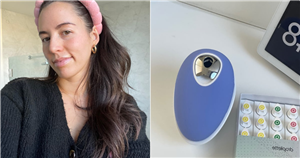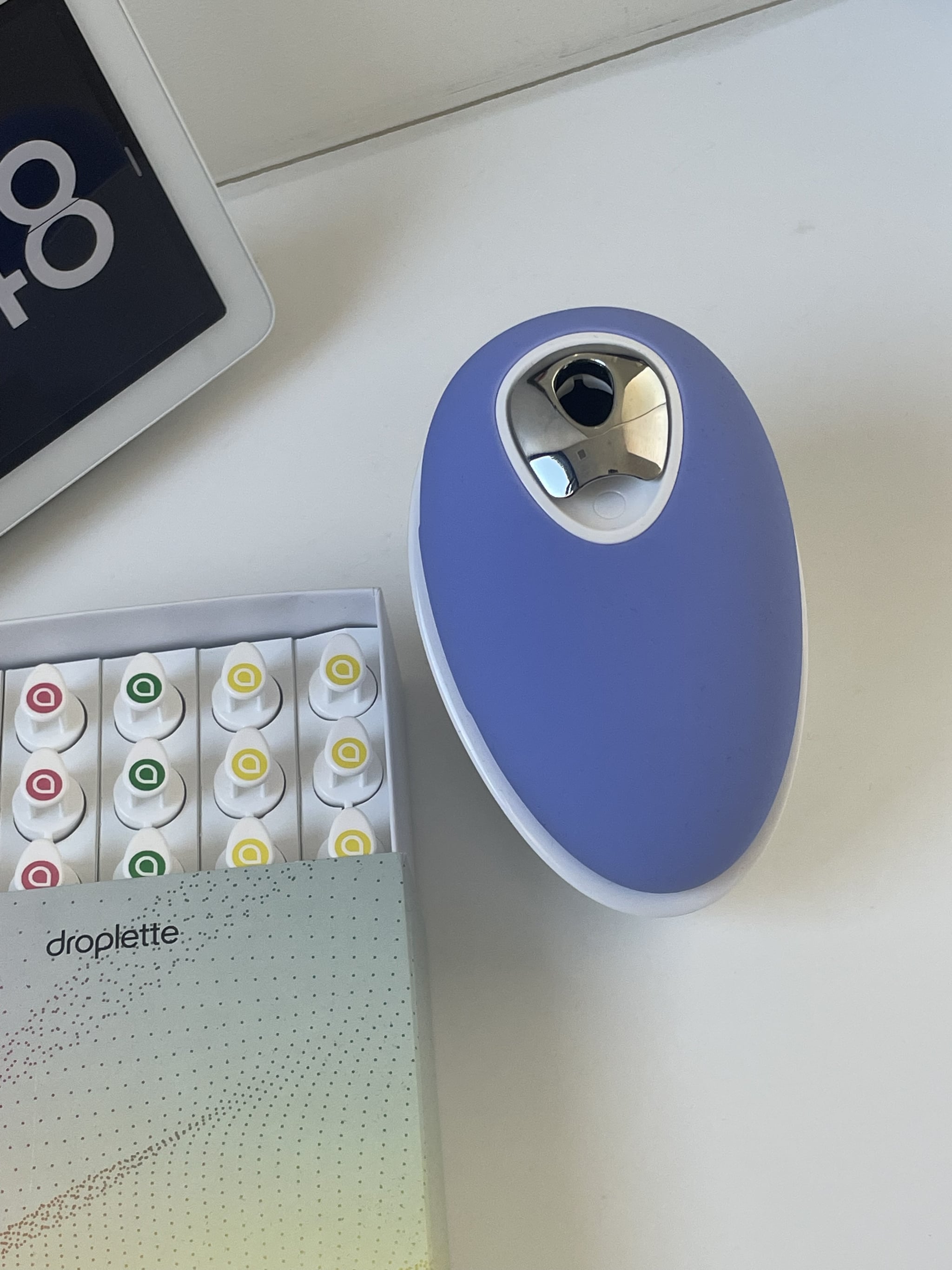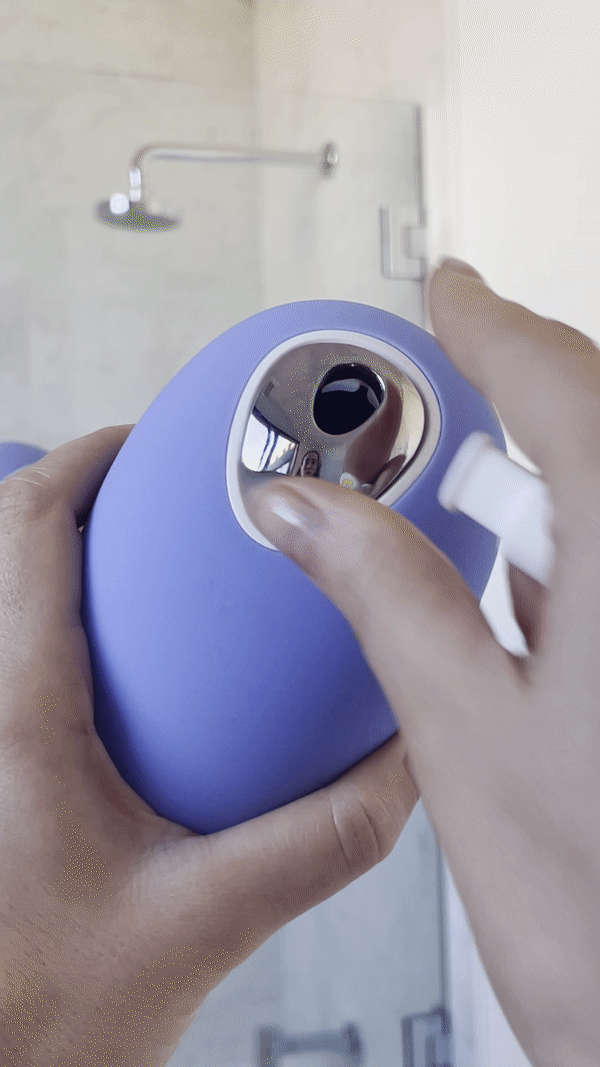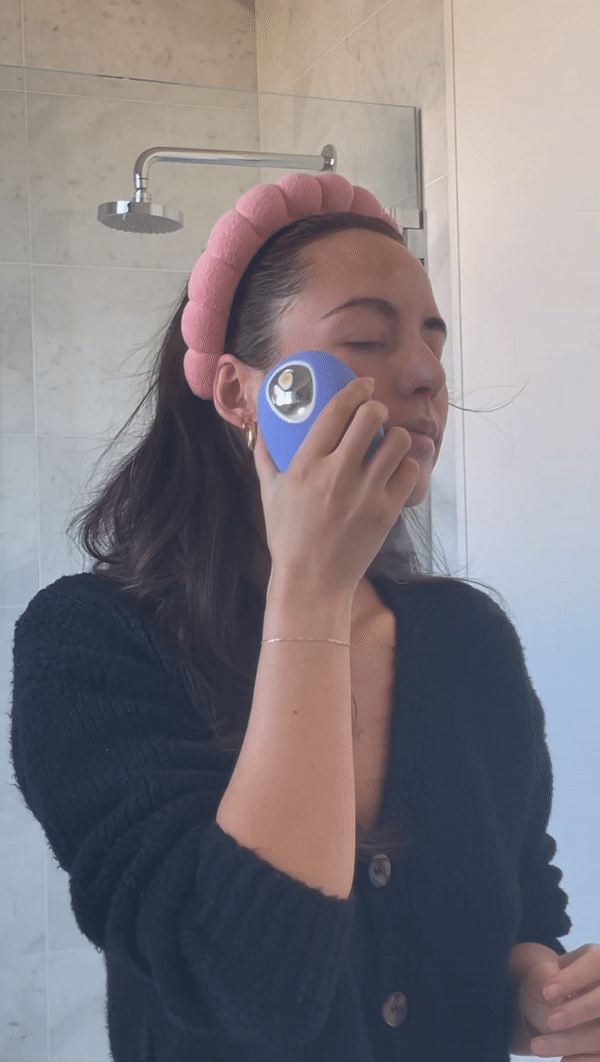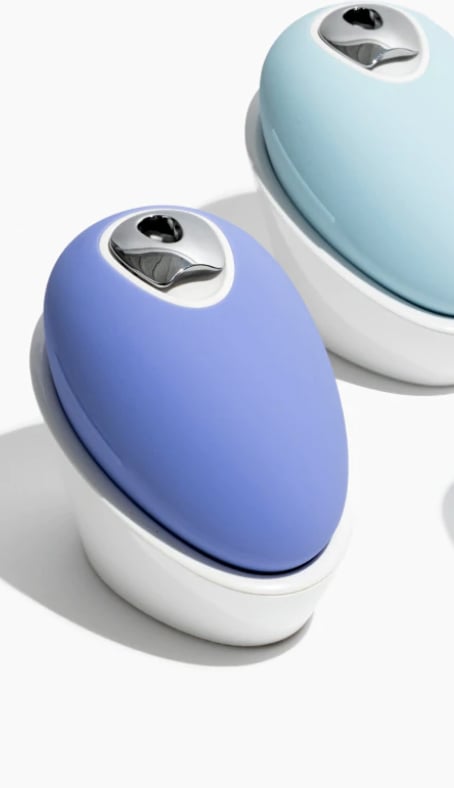- Droplette is a skin-care device that breaks down active ingredients into a micro mist.
- The smaller particles are meant to penetrate the skin’s barrier at a higher velocity, which promises maximum efficacy.
- Read one editor’s experience with the Droplette device ahead.
If you’re someone who loves topical actives when it comes to your skin care, I have some not-so-great news for you. Many of those expensive products you’re slathering on your skin day after day probably aren’t penetrating your skin’s surface. Our skin barrier is designed to deliberately keep things out and, as a result, only small molecules are ever actually absorbed.
Madhavi Gavini and Rathi Srinivas, two MIT-trained scientists, set out to change that with Droplette ($299), a new skin-care device meant to change how we apply our skin care. Think of your skin barrier as the hostess at Nobu Malibu: she’s not letting anyone in unless they’re really, really important. Then think of Droplette as your personal concierge: it’s getting you in, at a table overlooking the ocean, with zero waiting time.
Here’s everything else you need to know about the buzzy new tool.
What Is Droplette?
Droplette is NASA-backed, physics-powered device that breaks down actives into a micro mist, which is delivered into the skin via a high-velocity aerosol. The actives are stored in capsules that each contains the daily dose of a dermatologist-developed formulation.
Droplette offers three different capsule options: 10 percent Collagen Capsules, 0.15 percent Retinol Capsules, and 8 percent Glycolic Acid Capsules. The collagen capsules help plump and nourish skin, the retinol capsules help to smooth fine lines, and the glycolic acid capsules help to brighten skin and clear blemishes. The capsules come in a pack of 30 for $79 or 12 for $39.
How Does Droplette Work?
I knew that the fact that this product was described as a “physics-powered” device most likely meant that whatever made it actually work was going to be way over my head. I’m not the most scientific person, and I came very close to failing physics in high school. To help me make sense of how TF Droplette actually worked, I connected with the brand’s CEO, Madhavi Gavini, and asked her to explain the process in the simplest way possible.
The first thing Gavini explained was that things normally get absorbed through the skin via a process called diffusion. Diffusion is a natural process that happens over time, but it can take hours, if not longer, for things to absorb through your skin.
“When you think about actives — even something small enough to get in like vitamin C — if we’re talking hours, let’s be honest: most of it is going to get oxidized, it’s going to get destroyed by UV, or just in the course of your day, you’re going to sweat it off or wipe it off [before it can be fully absorbed],” she says. “For things that are bigger, like collagen or hyaluronic acid, it’s not going to get into your skin because it’s just too big. It’s like trying to get a really big thing in a very small hole. It’s just not going to happen.”
As Gavini was saying this, I was picturing all of the times I’ve tried to thread a needle and imagining if I needed to thread my needle with, say, a shoelace. Basically impossible. So how does Droplette make the impossible possible?
“What Droplette does differently is that we don’t use diffusion. It’s more of a mechanical thing where we’re forcing it through. We encapsulate [actives] in tiny droplets, we create an aerosol from it, and then we take that aerosol and we accelerate it. Once the aerosol is moving at a high speed,” says Gavini, “it increases evaporation, so the droplets get denser, and they get smaller. It’s moving at a high velocity, so it’s not just slowly diffusing; it’s pushing its way in.”
Eager to test the device out for myself, I used Droplette for a few months over the past year.
How to Use Droplette
The first thing I did after receiving my Droplette device was made sure it was fully charged. I then connected it to the Droplette app I downloaded on my phone. When it came time to actually try it out (and after watching a few informational videos first), I started with clean, dry skin, chose a capsule — I opted for collagen — and inserted it into the chamber of the device.
I held the white side of the device about half an inch away from my face, pressed the “on” button, and began moving the device in a circular motion, focusing on only one side of my face. The device runs in three 15-second intervals, so I repeated this process on each side of my face and then on my forehead. As for what I felt when this was going on, the answer is . . . nothing. OK, yes, I felt a very light mist on my face, but it truly didn’t feel like much.
As someone who needs instant gratification (I blame Amazon’s Prime shipping), I wasn’t sure how I felt about the lack of feeling, but Gavini says this feature is intentional. “We built this initially to treat pediatric patients with wounds. So, you don’t want something that’s going to cause a lot of pressure.”
Despite the fact that I couldn’t actually feel anything hitting my face, and the mist didn’t leave behind any sort of residue, I could certainly see the results. My face really did seem to look plumper and brighter immediately after my first use, and I’ve continued to see similar results every time I’ve used the collagen capsules.
As for Droplette’s other offerings, since I already use prescription topical retinol, I opted to skip out on that capsule altogether, but I did try the glycolic acid capsules. When I first watched the informational device on how to use the Droplette, they noted that for the glycolic capsules, users should hold the device even closer to their face, and they should also hold their breath while the device is working.
I followed their instructions to a tee, but I still found myself coughing every time I used the glycolic capsules, which immediately made me wary. When I asked Gavini about this, she said they’ve since updated their guidance on how to use the glycolic capsules. “What we’re telling people to do is just spot treat. Hold it up against the [affected] area, turn it on, and then turn it off. If you do that, very little of it escapes. For people who have cystic acne, it’s extremely effective.”
I don’t have cystic acne, but I do occasionally get acne breakouts. I’ve been using the method Gavini suggested for a few weeks, and it’s been a total game changer. I’m no longer coughing (whew!), and instead, I’m actually healing my acne breakouts much faster than usual.
The Verdict on Droplette
Although the process took some getting used to, I’ve come to look forward to my skin-care sessions with my Droplette, which I’ve affectionately named Penelope. (I went with a “P” name because she’s purple.)
As for the price, at $299 for just the device, this is one of the more expensive tools I’ve tried. However, for someone like me who has never tried an injectable (and frankly is way too scared to), the entire concept is revolutionary and well worth the cost. Although I’ve been in a committed relationship with my prescription retinol for almost two years, the Droplette device is actually making me consider giving it up just so I can have my retinol delivered via the micro mist I’ve come to know and love.
Rating:
Source: Read Full Article
